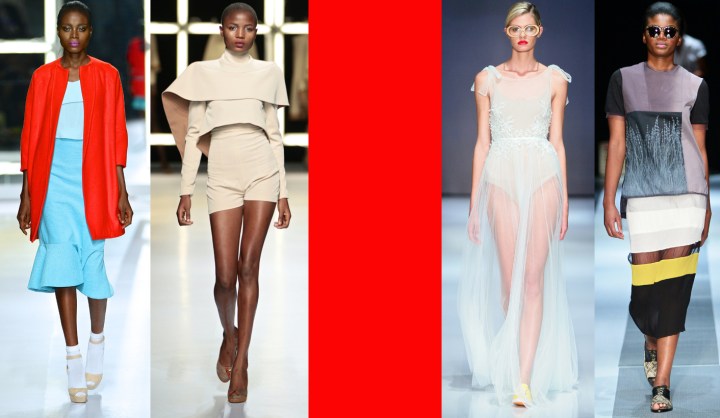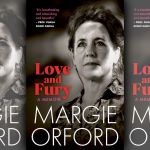Maverick Life
Chronicles of Chic: Fashion week vs. fashion week (Part II)

Volumes, structured silhouettes, bright colours and soft palettes dominated the newest instalments of South Africa's Fashion Weeks. One could find not only seasoned designers' seasonal pieces for the whole year but also cutting edge clothes made by talented emerging designers. It does look like SA's future fashion has a good story to tell. By EMILIE GAMBADE.
In the years past, local fashion weeks took on their catwalks collections that sometimes were confused and messy. It was not unusual to see on the runway unfinished garments with bright threads hanging from the hemlines, outfits that had not been ironed or steamed, ranges made of incoherent bits and pieces and price-stickers left under the sole of a model’s shoes.
This creative mumbling seemed to be an acceptable norm and out of all the designers showing at fashion weeks only very few passed the test of catwalk-worthiness; which means, as suggested by Eugene Rabkin, editor of StyleZeitgeist magazine, presenting a collection that has a strong aesthetic statement, a theatrical element and meaning.
A strong aesthetic statement implies a range with a ‘voice’, a tone, a signature, something that sets the collection apart. It could be because of its originality, its technical knack, its avant-garde feel or simply an extreme attention to detail, giving the clothes a unique panache. It could mean flirting with edginess, as seen at Comme des Garçons by Rei Kawakubo, Alexander Mc Queen or Maison Margiela, three brands with incredibly strong aesthetic statements; or following the example of Alexander Wang’s commercial line, a collection that is distinctive because of the designer’s ability to predict (and thus define) what will be cool and hype.
A theatrical element suggests a set-up, the case that will hold the collection. Be it at Tommy Hilfiger or Karl Lagerfeld’s staggering decors (he had a life-size supermarket built under the roof of the Grand Palais in Paris for the Chanel Ready-to-Wear A/W 2014) or locally, at Suzaan Heyns for her Autumn/ Winter 2013 collection, reminiscence of the ancient doors found in Zanzibar, staging a collection is breathing life into the clothes, sharing with the public the story of its very existence.
Then, a collection’s meaning is its raison d’être. Rabkin explains, “With this comes the responsibility, even the duty, for designers to infuse these products with something deeper through their design skills.” Essentially, it means garments that are unique, singular, carefully thought through and cannot be found in fast-fashion outlets. Ultimately, fashion retailers (like Zara) are the ones who usually copy the catwalks, not the other way round.
On the evidence of these seasons’ collections, both at AFI MBFW and at SAFW, it looked like the majority of the designers had done their homework and carefully ticked some of the design boxes. In keeping with a strict moodboard and a strong palette, the will was less to impress with empty oohs and aahs and disastrous folie des grandeurs, but more with edited ranges that had either a strong aesthetic, a theatrical element (as seen at Abigail Betz) or meaning, or even all of the above.
At AFI MBFW Joburg, Ayanda Mthembu did just that: editing. Under the hand and the eye of David Tlale, the young designer presented a collection like a resolute fashion statement. It was an experimentation of volumes and soft lines in nudes and light browns with rounded shoulders, tone-on-tone capes floating down the chest, pleated shorts and mini-skirts that worked as a whole but would have been as salient paired with denims or contrasted pieces. It was charming, desirable and ultra-feminine.

Photo: Ayanda Mthembu, AFI MBFW Joburg, Sandton Convention Centre, Simon Deiner/SDR Photo
Also under David Tlale’s guidance, Khothatso Tsotetsi for Tsotetsi KL, designed a collection that held a strong aesthetic. It was brightly pink with a touch of yellow, and brought in a hodgepodge of fabrics including fur, mesh and chiffon; it was also tight at the waist, a slim pink belt like a thread that strolled throughout the range. Dubbed “Defined Paranoia”, it could well have originated in the closets of Sex and the City Carrie Bradshaw, frills, volumes and girlishness adorably sliding on the pleats of an A-line skirt. A favourite was the deep pink bonbon, an ensemble made of a slightly oversized jacket and a flared matching skirt.

Photo: TsotetsiKL, AFI MBFW Joburg, Sandton Convention Centre, Simon Deiner / SDR Photo
Designer Celeste Arendse for Selfi is not exactly a debutante: she launched her brand in 2009 and is “currently stocked in over 12 independent boutiques country wide, two of which are international, based in Zurich, Switzerland and New York”. Although her collection was less convincing, maybe because it wasn’t as edited as for Mthembu’s and Tsotetsi’s ranges, there were individual pieces and looks that deserved praise, specifically the cropped tops in baby pink or the bright scarlet red straight jacket topping a turquoise ensemble and completed with fuchsia lips.

Photo: Selfi AFI MBFW Joburg, Sandton Convention Centre, Simon Deiner / SDR Photo
Adriaan Kuiters and Jody Paulsen’s work for A/W 2014 was comfortable, modern, with boy-meets-girl silhouettes, and interesting and fresh prints: one third geometrical, one third underwater world and one third pretty pop patterns with lips on the chest and hands hugging the waist. Here, boxy volumes, asymmetrical shapes, clash of fabrics, flannels, wool and fur met in funky harmony.


Photo: Adriaan Kuiters, AFI MBFW Joburg, Sandton Convention Centre, Simon Deiner / SDR Photo
At SAFW, no particular theatrical element for the collections shown at the Crowne Plaza in Rosebank, but some interesting aesthetics: for S/S 2014, Thembeka Vilakazi for Yadah mixed Zambian Chitenge fabric and shwe-shwe to create a range that had a strong African signature. What the silhouettes lacked in originality, they offset in bold prints, daring colours and lovely mishmash of fabrics. The jumpsuit with its integrated cape tied under a Peter Pan collar was very modern Lolita: sweet, feminine and sexy.

Photo: Yadah, SAFW Joburg, Crowne Plaza, Simon Deiner / SDR Photo
Jeanne Casey is “a specialist hand in the custom bridal industry”. Thus, she dodged bright colours and heavy fabrics in favour of evening dress silhouettes, whiteness (with one mutinous touch of neon yellow) and tulle, cotton and lace. She clearly paged through the photograph album of an old Hollywood glamour icon à la Rita Hayworth to create a romantic and ethereal range. It was simple yet detailed, delicate yet well made. A downside: the sneakers and the round spectacles that wanted to add contrast and ended up looking out of place.

Photo: Jeanne Casey, SAFW Joburg, Crowne Plaza, Simon Deiner / SDR Photo
SAFW explains that Terrence Bray “was named the ‘South African label to buy’ by British Vogue”. The Durban-born designer who launched his eponymous label sixteen years ago but still new at fashion weeks, likes to play with fabrics, prints and volumes, creating outfits that are not only wearable as is, but desirable. He doesn’t create garments; he propounds a style, a direction, something, like at Adriaan Kuiters, that makes you want to be loyal to the brand. For S/S 2014, there were mesh tops in khaki, light nude and black on top of printed t-shirt, crisp white shirt or bicolour shirt; also on trend, the pleats à la Issey Miyake, the asymmetrical stripes, oblique cuts and wide sleeves. Bray focused on one print, like the sketch of wild grass applied here on a top mirrored on the matching skirt, there on a dress, tight collar circling the neck. It was striking, different and designed for today’s woman.

Photo: Terrence Bray, SAFW Joburg, Crowne Plaza, Simon Deiner / SDR Photo
From the mumbling beginnings of fashion week to today’s shows, a lot has been done to improve the quality of the collections shown on the catwalks. At times, it is still unbridled, but for most, collections have found coherence, meaning and individual aesthetics. While designers have now to maintain their focus and build on their respective identity, fashion weeks need to find a way to merge and offer the industry the platform and the fashion calendar it deserves. DM
With additional research by Kelly Fung.
Read more:
-
Chronicles of Chic: Fashion Week vs. Fashion Week (Part I) at Daily Maverick















 Become an Insider
Become an Insider